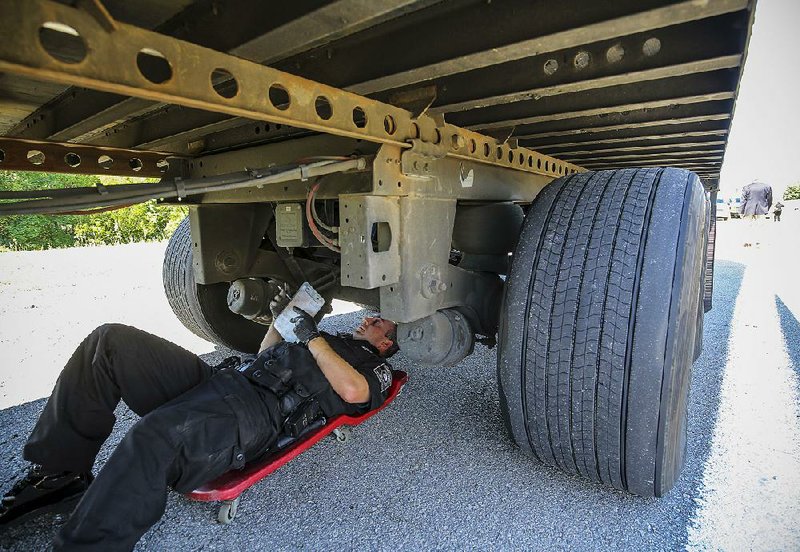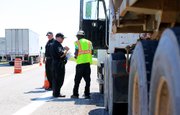Dozens of tractor-trailer rigs began rolling through an inspection station just west of Benton on Interstate 30 eastbound early Tuesday as part of an annual three-day international inspection program that looks for safety violations on big rigs.
In a small area off the interstate were Arkansas Highway Police officers, their vehicles and equipment set up to inspect randomly selected trucks before allowing most of them to continue their journeys.
By 9 a.m., three hours into the 72 hours of the inspection blitz, two trucks and their drivers had been pulled out of service and parked because of violations.
One driver was unable to document his hours on the road Tuesday, so he had to wait a mandatory 10 hours to rest or arrange for another driver to pick up his load, according to Maj. Jay Thompson of the Arkansas Highway Police.
"We don't know how long he's been driving," Thompson said of the sidelined trucker.
Driver fatigue is a crash risk, according to industry data. Under federal hours-of-service regulations, drivers of big trucks are allowed to drive up to 11 hours at a stretch and up to 77 hours over a seven-day period.
Another driver's truck had two flat tires and brakes that were out of adjustment, all of which had to be repaired before the truck was allowed on the road again, Thompson said.
Truck braking capability can also be a factor in crashes, according to the Insurance Institute for Highway Safety. It takes loaded tractor-trailers 20 percent to 40 percent more distance to stop than it does cars, and that difference increases on wet and slippery roads or for trucks with poorly maintained brakes, according to the institute.
Fernando Garza, 40, traveling Tuesday with another driver sharing the duties, was hauling a load of automotive parts from Laredo, Texas, to Buffalo, N.Y., when his truck was singled out for a random inspection at the I-30 inspection site. Other trucks were waived through the checkpoint.
"It's all good," Garza said as he sat patiently in the cab of the late-model Freightliner that has traveled 50,000 miles since he began driving it two months ago for Point Dedication Service of Troy, Mich.
Cpl. Kreston Taylor of the Arkansas Highway Police put Garza and the truck through a 37-point inspection.
His rig was one of the estimated 17 trucks per minute that will be inspected through 6 a.m. Thursday as part of the 2016 International Roadcheck. The program, coordinated by the Commercial Vehicle Safety Alliance, will involve 10,000 inspectors on roadways reaching from Canada to Mexico.
This year the program has a special emphasis on tire safety, including tread depth, air pressure, visible bulges and overall condition.
The International Roadcheck "is the largest targeted enforcement program for trucks in the world," said Thompson, who is president of the alliance, a nonprofit with a mission statement of promoting commercial motor vehicle safety and security by providing leadership to enforcement, industry and policymakers.
Taylor was all business has he conducted the North American Standard Level 1 Inspection.
Taylor ran Garza's commercial driver's license through a database checking for violations and reviewed Garza's documentation on service hours. Then Taylor turned his attention to the truck. He peered into various systems, checking among other things the brakes, drive shaft, suspension and lights.
At times, he enlisted Garza's assistance in turning on the lights and checking the horn, or asking Garza to disconnect hoses or perform other tasks. A typical inspection lasts 30-45 minutes. Garza and his truck passed. All the while the truck was being inspected, his fellow driver slept inside the cab.
Thompson and his fellow officers say they are serious about the inspections because the stakes are high.
A total of 3,660 people died in large-truck crashes in 2014, the latest year for which data are available, according to the institute.
The number of people killed in large-truck crashes was 16 percent higher in 2014 than it was in 2009, the year when it was lower than for any year since collection of fatal crash data began in 1975, according to the institute.
Since 1979, when deaths in large-truck crashes were at an all-time high, such deaths overall have declined 57 percent, according to the institute. Since that year, deaths in passenger vehicles have declined 41 percent, the institute reported.
The trucking industry supports the inspection initiative, which organizers say serves to highlight the inspections that routinely take place daily. In Arkansas, 30,000 random or warranted truck and driver inspections were conducted last year, according to Thompson.
"The trucking industry's workplace is on our nation's highways, and we are committed to keeping them safe for everyone that we share the road with," said David O'Neal, director of safety services for the Arkansas Trucking Association. "Inspections help us remember that commitment every day."
Jerry Whittenburg, 61, of Beebe has driven a truck for Stallion Express of Beebe for 42 years, covering more than 4 million miles on the road in 48 states and much of Canada.
He doesn't mind the inspections.
"Having a check makes us more aware of what we're doing wrong," Whittenburg said. "It helps make companies be better companies in terms of safety."
Dealing with the inspections and the accompanying paperwork is much less stressful than driving a big rig on highways shared with smaller vehicles, he said.
"You still have to drive the truck and watch for the cars and pickups and stay out of their way," Whittenburg said. "That's the biggest challenge for us."
Metro on 06/08/2016

